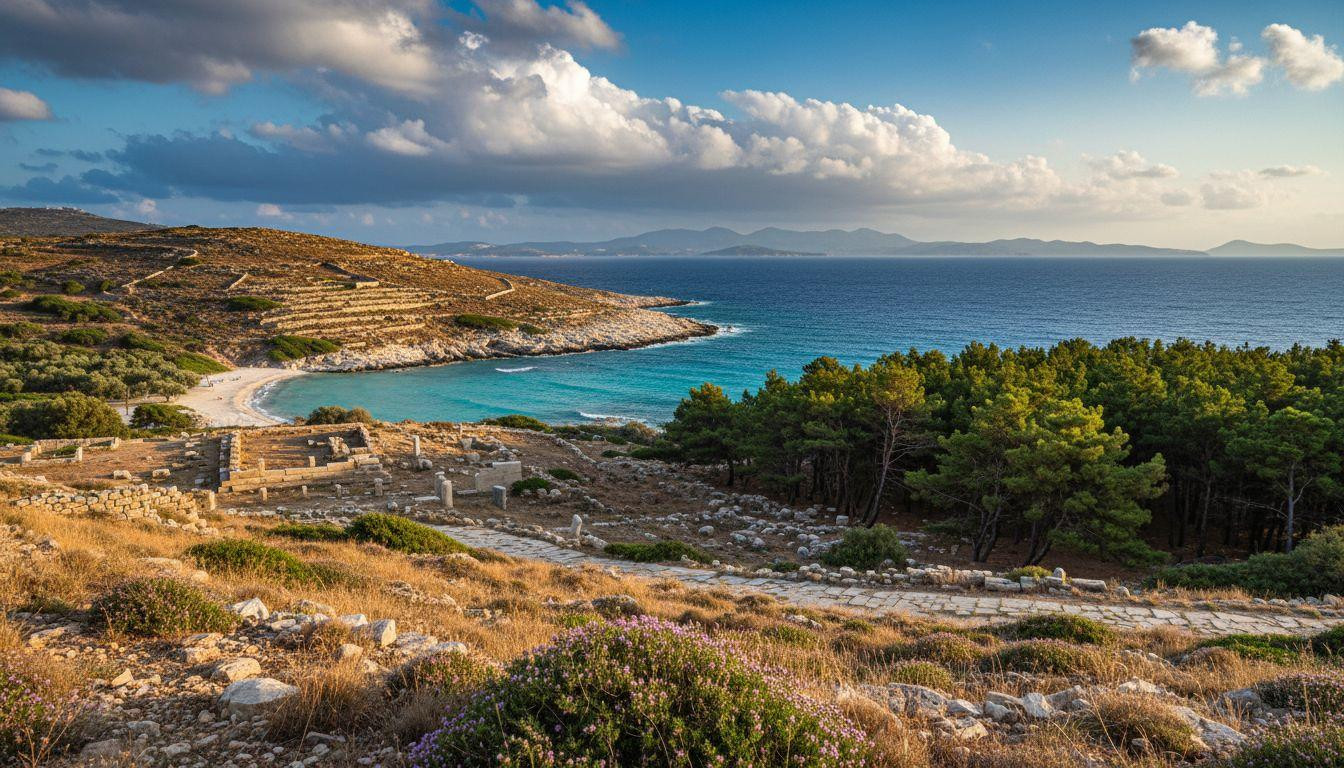The morning ferry from Mykonos churns past a forgotten island. Tourists photograph Delos ahead, phones raised toward the famous UNESCO ruins. Behind them, Rineia spreads its 14 square miles of golden hills and turquoise coves in perfect silence. No crowds. No entrance fees. No guided tours with whistles and ropes.
This overlooked sanctuary holds the same ancient stories as its famous neighbor. Yet while other Greek islands struggle with overtourism, Rineia welcomes only 10,000-15,000 visitors annually to its pristine wilderness.
Forget Delos and its museum-like restrictions
Delos receives over 100,000 visitors each year. They arrive on scheduled boats, follow designated pathways, and photograph ruins behind protective barriers. The experience feels institutional rather than mystical.
Tour guides use megaphones to address groups of 30. Visitors queue for photos at the Terrace of Lions. The small island (just 1.3 square miles) concentrates its crowds into archaeological zones that feel more like outdoor museums than sacred spaces.
Summer brings additional challenges. The sun reflects off white marble without shade trees. Strong north winds from the central Aegean create harsh conditions for exploration. Many visitors leave feeling they’ve checked off a UNESCO site rather than connected with ancient Greece.
Discover Rineia’s sacred wilderness alternative
Two miles west of Delos lies its historical twin. In 426 BC, Athens purified Delos by moving all graves to neighboring Rineia. The island became the cemetery where life and death coexisted with the sacred.
Unlike Delos’ compact ruins, Rineia spreads ancient remains across 27 miles of coastline. Stone foundations emerge from wild thyme. Marble fragments rest among maritime pines. The archaeology feels alive, integrated with landscape rather than separated from it.
Beaches Delos cannot offer
Glyfada Beach curves along the southern shore in perfect crescents of white sand. Water temperature reaches 72°F in summer. No swimming restrictions exist here.
Stena Bay offers shallow turquoise pools perfect for families. Lia Beach provides deeper water for serious swimmers. Mediterranean coves like these rival any Cycladic paradise.
Living traditions vs museum displays
Mykonos farmers still cultivate Rineia’s valleys each spring. They tend olive groves planted generations ago. Small stone churches host village festivals during Greek Orthodox celebrations.
Goats graze ancient terraces where Roman citizens once walked. The island breathes with authentic rhythms impossible on preserved Delos. This continuity connects visitors to unbroken Mediterranean traditions.
Your Rineia experience starts here
Boat excursions from Mykonos cost $80-100 per person for full-day trips. Private charters range from $550-1,650 depending on vessel size and season. The 30-minute crossing reveals both islands’ relationship as you approach.
No facilities exist on Rineia itself. Bring water, sun protection, and sturdy hiking shoes. The island rewards preparation with complete solitude and photographic opportunities impossible on crowded Delos.
Hiking ancient pathways without crowds
Stone-paved Roman roads connect archaeological sites across the interior. Hikers discover temple foundations without protective barriers or tour group noise. The freedom to explore personally creates profound connections with ancient Greek spirituality.
Maritime pine forests provide shade during midday heat. Wildflowers bloom from February through May. Island sanctuaries like this preserve Mediterranean ecosystems alongside cultural heritage.
Traditional Greek flavors without tourist markup
Most excursions include lunch prepared by Mykonos boat crews. Expect fresh fish, local cheeses, and olive oil from family groves. Kopanisti cheese (spiced with local herbs) appears frequently on these authentic menus.
Some tours stop at traditional fishing spots where crews demonstrate ancient techniques still used today. The experience contrasts sharply with Delos’ sterile archaeological presentation.
Why Rineia surpasses its famous neighbor
Delos preserves Greece’s museum-quality past perfectly. Rineia preserves its living relationship with landscape and tradition. The comparison isn’t about better or worse, but about different ways of experiencing Greek heritage.
Photography flows freely without crowd management concerns. Dramatic coastal scenes emerge naturally rather than through orchestrated viewpoints. The island rewards patient exploration with discoveries impossible on regulated sites.
Budget-conscious travelers appreciate Rineia’s free access once transportation is arranged. Delos charges entrance fees plus mandatory boat tour costs, often exceeding $150 per person for comparable experiences.
Your questions about Rineia answered
Can I visit Rineia independently without organized tours?
Private boat charters from Mykonos allow independent exploration. Many captains offer flexible schedules for photographers and hikers wanting extended time ashore. Advance booking ensures availability during peak season (July-August).
What archaeological sites remain visible on Rineia today?
Ancient cemetery remains, Roman villa foundations, and early Christian church ruins scatter across the island. Unlike Delos’ concentrated sites, Rineia’s archaeology integrates naturally with landscape. Visitors discover fragments organically rather than following designated pathways.
How does Rineia compare to other overlooked Greek islands?
Rineia offers unique advantages: proximity to Mykonos infrastructure, significant archaeological heritage, and complete absence of development. Unlike remote islands requiring extensive planning, Rineia provides wilderness experiences within day-trip distance of major tourist hubs.
Evening light paints Rineia’s hills amber as your boat returns to Mykonos harbor. Delos’ famous columns catch the last sun across the narrow channel. Both islands sacred, both ancient. One preserved behind velvet ropes, the other alive with wind through wild thyme.
